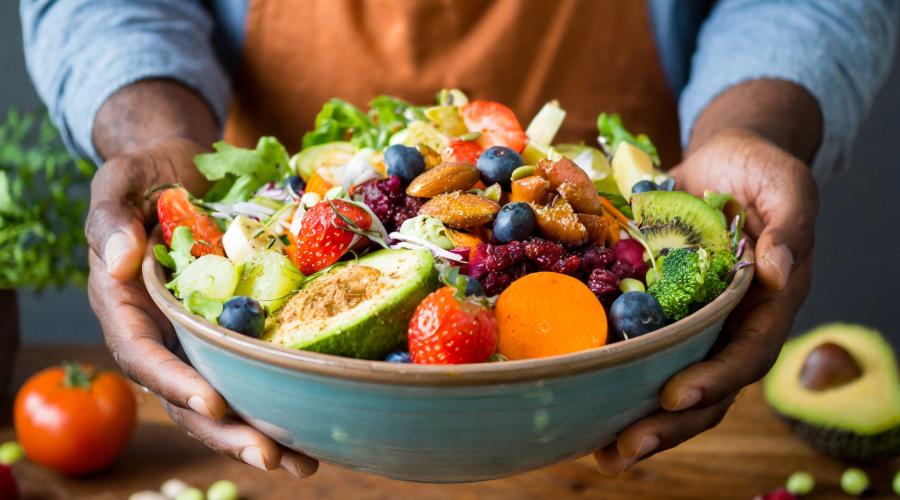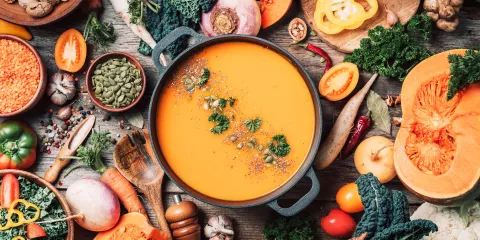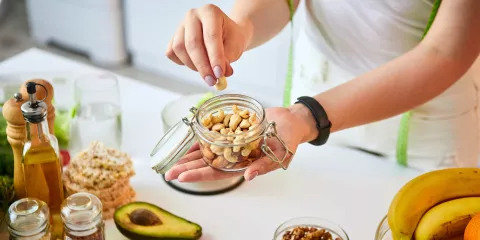
Curious about the paleo diet? From TV to social media to friends and family, many people recommend this diet as a means to eat healthier or lose weight. But, is it actually true?
In this post, we’ll give you an overview of the paleo diet. This includes what it is, how to follow it safely and additional information about difficulty and supplementation.
We hope this post will empower you to make individualized dietary decisions alongside your healthcare provider.
What Is the Paleo Diet?
The paleo diet goes by several names, including the Paleolithic diet, the caveman diet, the hunter-gatherer diet and the Stone Age diet.1 Many people try paleo for weight loss. While some studies indicate weight loss benefits, more high-quality research is needed to draw any conclusions for the general population.2 There are also some risks associated with the paleo diet, which we will discuss later in this post.
The main goal of the paleo diet is to “eat like our ancient ancestors,” which would have been anything they could hunt, fish or gather.
Our ancestors didn’t have the means to create cupcakes, potato chips, crackers and other processed foods, so these are eliminated from the diet. Instead, you want to eat whole and unprocessed foods: fresh meats, fruits and vegetables (to name a few). In summary, the less processed, the better!
However, you’ll also see other foods eliminated from the paleo diet, some of which are considered healthy foods by trusted nutrition organizations. Keep reading to find out what those foods are.
How to Follow a Paleo Diet (Safely)
Overall, there are two goals of the paleo diet: cut out processed foods and eat more unprocessed foods. We’ll go into more detail so you have a better idea of what to eat and what to avoid on the paleo diet.
Cut Back on Processed Foods
As mentioned before, the paleo diet aims to cut out all processed foods. Since our ancient ancestors didn’t have access to processed foods, they are to be excluded from the diet.
The term “processed” can vary depending on who you ask. One person may consider processed food to be anything that comes in a package. Someone else may consider it to be anything that contains more than one ingredient. Another may consider processed foods to have additives.
Researchers differentiate between minimally processed foods, such as lettuce that has been washed and packaged, and ultra-processed foods that typically contain ingredients not used in home food preparation, such as sweetened breakfast cereals.1 The Academy of Nutrition and Dietetics ("AND) has a scale of minimally processed versus heavily processed foods.11
Related: Heart-healthy Diet Essentials & Meal Plan
Many people who follow the paleo diet cut out the following foods:1,3
- Fast food
- Soda
- Sweeteners
- Salami
- Sausage
- Crackers
- Bread
- Grains (white and whole grains)
- Dairy (milk, yogurt and cheese)
- Legumes (beans and soy)
- Packaged snack foods
- Packaged meals
- Vegetable oil
- Conventional farm-raised meat
- Starchy vegetables (potatoes, corn, peas)
As you can see, a few of these restricted items – like yogurt, (non-fat and low-fat), and whole grains – are typically considered healthy by major nutrition organizations such as the American Heart Association (AHA) and AND.4-9
Strict adherence to the paleo diet would require you to cut out all processed foods, including anything that is farmed or otherwise manipulated from its original source – even if it is considered “healthy” such as whole grains and low-fat dairy.1
However, if you still wanted to reap the benefits of healthy grains, low-fat dairy and legumes, you could choose to follow a “modified” paleo diet. This would help to ensure you’re getting a more well-rounded nutrient profile.10
Eat More Whole, Unprocessed Foods
Now that you know what foods to avoid on the paleo diet, what foods can you eat? Prioritize minimally processed whole foods and those with very few ingredients.
Here is a list of foods that are acceptable on the paleo diet:.1
- Fresh fruit
- Fresh vegetables
- Eggs
- Whole cuts of meat, poultry or fish
- Nuts and seeds
- Herbs and spices
- Olive, walnut, or avocado oils
- Wild game
- Grass-fed beef
- Meat that is fed a “natural” diet
To add more variety and flexibility to the diet, you could relax the rules a bit. For example: Plain frozen fruit with no added sugar tends to have just as much nutrition as fresh fruit. It also will last longer, making it convenient and cost-effective to have on hand. You can still follow the paleo eating plan, even with a few shortcuts.
Read More: Fresh vs. Canned vs Frozen: Which Is Better?
Paleo Diet FAQs
We’ll answer some commonly asked questions about the paleo diet so that you can better determine if it’s right for you.
What Are the Benefits of the Paleo Diet?
There are a few benefits to the paleo diet, more specifically:
- Limits processed foods:A huge benefit is that it inspires people to eat less added sugar, sodium, ultra-processed meat and empty-calorie snack foods, which aligns with evidence-based healthy eating standards.
- Promotes fruit and vegetable intake:Almost everyone should be eating more fruits and vegetables! If following a paleo diet helps you add more nutritious produce to your meals, that can help to improve your overall health.10
Eat Up: 12 Months Of Healthy Eating: Colors Of The Rainbow
Is it Hard to Follow a Paleo Diet?
Compared to other diets, the paleo diet is fairly easy to follow. Its guidelines are pretty straightforward and simple, with the exception of cutting out a few “healthy” items like whole grains and legumes.
One concern is the cost of following a true paleo diet. When shopping for food, many people may find themselves spending more on minimally processed foods, specialty local foods, wild game and the like.
While many people try strict adherence to the diet, it can be modified to align with general healthy eating guidelines (and your budget). By including some cost-effective and convenient shelf-stable foods (canned water packed tuna, sodium-free canned chicken) and frozen foods (fruits, vegetables, fish filets), you may be able to reduce the overall cost of paleo.
Are There Safety Concerns with the Paleo Diet?
Prior to starting a new diet, consult with your doctor and/or dietitian. Depending on your individual health profile and use of medications, certain diets can put you at heightened risk for nutrient deficiencies, worsening of health status and/or adverse drug-nutrient interactions.
Let’s talk about specific things to be aware of in regard to the paleo diet:
- Potential negative impact on heart health:Paleo diets have the potential to be high in unhealthy saturated fats, which can impact your cardiovascular system.10 This may occur if you consume too much red meat and non-lean poultry, even if it’s fresh.
- Potential for unnecessary food restriction:The paleo diet calls for avoiding grains, including whole grains, legumes and low-fat dairy, all of which are generally considered healthy and/or nutritious.
- Potential for inaccurate information:When you search for information about the paleo diet, you’ll find a set of general guidelines with a heavy emphasis on meat. However, we are not 100% certain about what our ancient ancestors really ate. Plus, their diets were highly dependent on where they lived and what was available.
Do I Need to Take Supplements on a Paleo Diet?
In most cases, it is best to obtain nutrients from food sources first. Supplements can be used to fill in nutritional gaps, meet specific nutrient needs and/or when one’s diet lacks certain nutrients.
Remember to consult with your doctor before starting or changing your supplement regimen. Supplements can play a part in your health status and how certain medications work.
When following a paleo diet, pay attention to the following nutrients:1,3,8-10
- Fiber
- Calcium
- B vitamins
- Vitamin D
When you’re deficient in certain nutrients, supplementation and/or dietary changes may be required. Supplementation should be discussed and analyzed by a healthcare provider prior to starting.
Get The Guide: How Supplements Can Support Your Healthy Lifestyle
In Summary
The paleo diet is fairly straightforward and easy to understand for most people. If you remember to cut back on processed foods and choose whole foods more often, you can abide by most paleo diet guidelines.
This diet also allows for some flexibility. While the standard paleo diet has some inconsistencies with widely accepted healthy eating guidelines, it can be modified to align with recommendations from major nutrition organizations and your individual health profile.
References
1 Mayo Clinic. Paleo diet: What it is and why is it so popular? Mayo Clinic Website. Published October 20, 2022. Accessed March 20, 2023.
2 de Menezes EVA, de Carvalho Sampaio HA, Ferreira Carioca AA, Andrade Parente N, Oliveira Brito F, Magalhaes Moreira TM, de Souza ACC, Machado Arruda SP. Influence of the Paleolithic diet on anthropometric markers in chronic diseases: a systematic review and meta-analysis. Nutr J. 2019;18(41). doi: https://doi.org/10.1186/s12937-019-0457-z
3 Cleveland Clinic. Paleo diet 101: What you can and can’t eat. Cleveland Clinic Website. Published February 3, 2023. Accessed March 20, 2023.
4 AHA. Dairy products - milk, yogurt and cheese. AHA Website. Published April 16, 2018. Accessed March 20, 2023.
5 Ellis E. What to look for in yogurt. Eat Right Website. Published June 8, 2022. Accessed March 20, 2023.
6 AHA. Whole grains, refined grains and dietary fiber. AHA Website. Published November 1, 2021. Accessed March 20, 2023.
7 Ellis E. What is a whole grain? Eat Right Website. Published August 4, 2021. Accessed March 20, 2023.
8 Polak R. Phillips EM, Campbell A. Legumes: Health benefits and culinary approaches to increase intake. Clin Diabetes. 2015;33(4):198-205.
9 Rozenberg S, Body JJ, Bruyère O, Bergmann P, Brandi ML, Cooper C, Devogelaer JP, Gielen E, Goemaere S, Kaufman JM, Rizzoli R, Reginster JY. Effects of dairy products consumption on health: Benefits and beliefs - A commentary from the Belgian Bone Club and the European Society for Clinical and Economic Aspects of Osteoporosis, Osteoarthritis and Musculoskeletal Diseases. Calcif Tissue Int. 2016;98(1):1-17. doi: 10.1007/s00223-015-0062-x
10 Good Food Is Good Medicine. Paleo diet: What it is and why it’s not for everyone. UC Davis Health Website. Published April 27, 2022. Accessed March 20, 2023.
11 Harguth A. What you should know about processed foods. Mayo Clinic Website. Published March 21, 2022. Accessed March 20, 2023.












